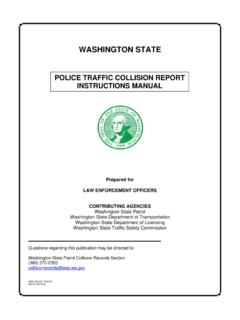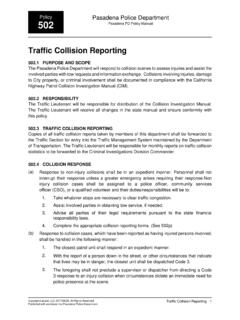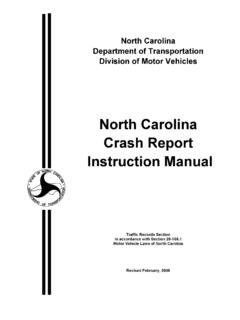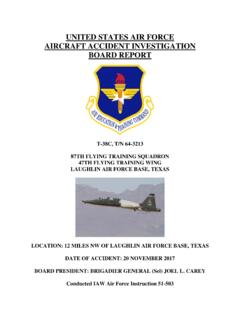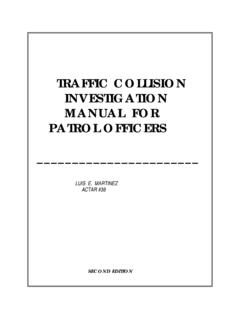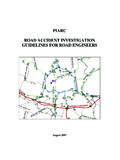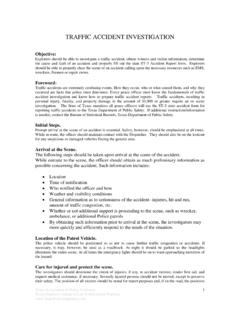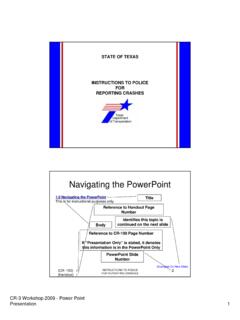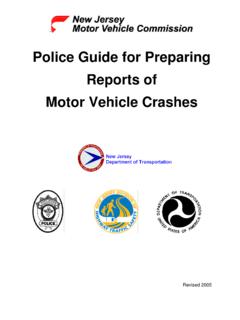Transcription of traffic collision database system - Crossroads Software
1 traffic collisiondatabase system210 W. Birch Street, Suite 207 Brea, CA 92821(714) 990-6433 Fax: (714) Software user s manualTABLE OF CONTENTSP reface: Some Basics Before You Begin1 Chapter One: Installing the traffic collision Database3 Step One3 Step Two5 Step Three5 Step Four6 Step Five7 Step Six7 Step Seven8 Step Eight10 Step Nine11 Step Ten13 Step Eleven17 Chapter Two: The traffic collision Database18 Introduction18 Part One: collision Records: Inputting, Editing, and Deleting Input Records by Street Name Soft Verification of Street Hard Verification of Street Verifying a Specific Entering collision Reports Using the CollisionInput Entering collision Information Through a Read/Write Edit and Print collision Delete Collisions40iPart Two: Citations and Citations and Delete Citations or Edit Read/Write Reports49 Part Three: Parking Parking Edit Parking Delete Parking Citations54 Chapter Three: Queries and General Intersection Intersection High Ranking by collision Using Page 2 of the Intersection High Midblock Historical Midblock High Reports by collision Queries by the collision Statistical Custom Query Citation Citation General Query91 Chapter Four: Graphs and Producing Graphs and Graphs by Year, Month, and Day of Week98 Chapter Five: Data Duplicate Records Check102iiChapter Six: Configuration105iiiPREFACESome Basics Before You BeginBefore you begin using Crossroads Software 's traffic collision database , you should be familiar with the basic layout of the structure and several commands (or, rather, clicks ) that you will use traffic collision database employs the familiar Windows Software , which means you will rely on buttons, pull-down menus, and similar features.
2 If this were the 1980s (and be thankful that it's not), you would have to enter those annoying and easily forgettable DOS key commands. Fortunately, DOS (at least for most of us) is a thing of the back and forth through the program is actually quite easy. Buttons, or, rather, descriptive boxes, will take you to different features of the Software . All that is required is a simple mouse return to the previous screen, simply click on the exit button, which looks like this:Note that the door button is not present in every screen in the database . When it is not present, you will see other buttons that allow you to complete your tasks and then return to the previous screen. These buttons might say exit, input , cancel, or delete. In output report screens, you can click on the File menu at the top to pull down the menu, scroll your cursor over Exit or Close and then click once to execute the return to the main menu, simply select the exit to main menu button:When inputting data, some fields are structured for ease of use and feature drop-down menus.
3 You can utilize this feature by a simple mouse-click on the down arrow to the right of the input other wonderful features include auto-match and limit to list. As you type an entry into a drop-down list, the Software will match the entry, filling in possible matches as you type and saving you key-strokes and time. This is the auto-match feature. Limit to List applies to those fields in the database that have drop-down menus. Not every field is a Limit to List field, but some are -- this means that the information you enter into the field must be contained within the items in the drop-down list. If the information is not among the list, the database will tell you that it cannot accept your entry. An example of this is a Direction field which contains a drop-down list with North, South, East, and West. If you were to enter a direction other than one of these four -- say, up or down or north by northwest -- you will be notified that you need to use one of the selections among the aspects of the collision database , things to remember, and other noteworthy items are marked by a hand icon :When you see the hand note, make sure you take a moment to read what follows; it is often important information about using the traffic collision and manual is divided into chapters for reading convenience, and each chapter is divided into sections.
4 The pattern for chapter divisions is the chapter number followed by the section number, and the sections follow in consecutive order. So, for example, the first section is labeled , the second , the third , and so on. Each section has its own heading, typically in bold letters, such as this: Soft Verification of Street Names. You can also use the Table of Contents to find your way through this book, particularly when you want to look up only one or two ONEI nstalling the traffic collision DatabaseIf you are familiar with installation of Windows-based programs, then installing Crossroads Software 's traffic collision database should be quite simple. If you are not familiar with Windows-based programs, then guess what? Installing the traffic collision database is still quite simple! Crossroads Software has provided you with a CD containing the traffic collision database application and data installing the Software , remember to close all Windows programs, otherwise they might interfere and create problems.
5 Also make sure that your computer's hard drive has about 120 MB of free disk the CD in hand, just follow the ONEP lace the Crossroads Software CD in your computer s CD-ROM drive. You need to locate and open the file. There are two ways to do this: using Run in the Start Menu or using My Through RunFig. 13 Click and open the Windows Start Menu on the Taskbar and select This brings up the Run dialog box, as seen above. Click on the Browse button to open a separate dialog box that will let you navigate through your computer and network. Locate the CD-ROM drive and click on it to highlight it. You should see a folder titled collision database Installation. It contains the installation files for the collision database . Open the folder and find the file titled Click on the file to highlight it and then hit Open. Windows will place the path name to the file in the Run box, as shown in the Run box image above. D represents the letter of the CD-ROM drive; it's followed by the folder name and then the file you already know which letter represents your CD-ROM drive, you can type in the path name in the Run box.
6 It should have the following format:D:\ collision database Installation\ D represents the letter of the CD-ROM OK to run setup. Go to Step Through My ComputerIf you prefer, you can install the collision database through the Windows desktop. Double-click My Computer to open its window and then double-click the CD-ROM icon. You should see a folder titled collision database Installation. Double-click on the folder to reveal the for the fileFig. 24 STEP TWOA fter opening the file, you will see a welcome screen (Fig. 3).Fig. 3 The welcome screen contains a few preliminary instructions as well copyright information. To continue with setup, just hit OK. If you do not want to install the database at this moment, choose Exit Setup. And if you want further information on setup, click Help. STEP THREEThe third step involves selecting a directory; in other words, telling the Software where to place the program files and data. Setup creates a default directory, containing a Crossroads folder (abbreviated Crossrds )we recommend that you use the default directory.
7 Of course, it can be changed, but for ease of use and for the ease of future updates, it is best to use the given 4 As shown in Fig. 4, the default directory is C:\Crossrds. To change the destination, use the Change button. You can also exit setup if proceed, just click OK. STEP FOURNow you are ready to begin installation. Click on the Complete button (Fig. 5). You still have the option of changing the directory or exiting Complete to begin 56 STEP FIVEWhen new programs are installed in Windows, Windows itself sometimes creates program groups. A program group connotes several programs or program-related files that are placed together in one location, usually a single folder. After beginning the installation process, the collision database setup will specify a program can change the program group if you want, but setup does create a default program group. We do recommend that you stay with the default 6 After verifying the program group, hit Continue.
8 STEP SIXSit back, relax, and wait while the program installs. You might be asked to restart Windows to complete the setup; if this happens, go ahead and restart. Once the files have been installed from the CD, you should see a window containing the program icons that are contained in the Programs section of the Windows Start menu (Fig. 7).7 Fig. 7 The main icon is the Crossroads collision database icon, which opens the collision SEVENThe Launch MenuInstalling the collision database from the CD is the main part of the setup process, but it is not the entire process. Once the program is installed, open the database by either double-clicking the program icon (it will probably be the shortcut in the Start menu folder, as shown in Fig. 7 above) or by clicking Start, navigating to Programs, moving over to Crossroads collision database , and then highlighting and clicking the Crossroads collision database icon. Opening the program will bring up the Launch Menu (Fig.)
9 8).8 Fig. 8 The Launch Menu provides a variety of options, which include:Full collision database : includes all input and edit options, all queries and reports, and all verification Module: the laptop version of the database for use by officers in the Module: allows only the input of data (no editing, verification, queries, or reports).Query Only Module: allows only queries and reports, graphs and reports (no input or edit features).Submit Module: works as an approval process to oversee and check data input and collision reports before the data is input into the full traffic collision database ; used in particular with data input through the Input Module and Laptop : configures the database so that it can run properly; make sure to use this feature after installation but before running the database . Repair a database : every once in a while, you might receive an error message stating that the database files are corrupt; click on this feature to fix the to Windows: closes the entire database EIGHTP rogram StatusWhen you select Show Program Status in the Launch Menu, a series of fields appears listing the main components of the database , their location, and their 9 The left column lists the necessary components: local program files, contained in ( mdb stands for Microsoft database ); local data files, embodied in ; and data files, contained in You've probably noticed that the data files have slightly different names: the local data files have an l at the end of Collisn, while the main data files do not.
10 The reason is that, depending on how your computer is set up, the program will read to different data local data files simply include the data inputted in the computer on which you are working. If you work on a computer network, all of the inputting done on local computers will be read into the main data files located on the network's central addition, if you are working in the Input Module or the Laptop Module, data will be placed in the local data files until transferred to the main data important thing to remember here is that, if you are working on a network, the data files and their locations should be setup properly so that the database functions correctly, and this is where Program Status comes in. Notice that the column in the middle shows the path names and locations of the data files. The columns on the right show the current status. If the status of each is Connected, then the database will run properly. If the status says Not Connected, then either the data files (the mdb files) need to be placed in their proper locations or the path names need to be you need to change the path names, you must enter the Configuration screen and make the appropriate changes (see Step Nine below).

